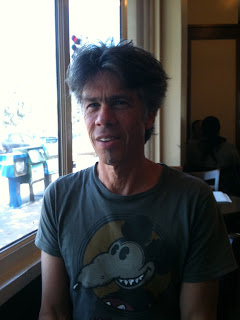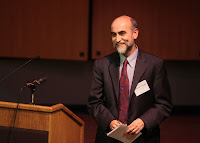I t's going to be one exciting weekend at the National Ballet School for anyone who has their tickets for
Yoga Festival Toronto. With so many wonderful yoga workshops, speakers and authors in attendance between August 19-21st at
Yoga Festival Toronto 2011 it's hard to narrow down a preview. But I did want to bring attention to two events that are free to the public.
The first is the closing chant of the festival. Yes, the festival exits with the best kind of enchantment; that is, the chant of a great story. Everyone knows there's nothing better than a fantastic story...but the power of a great story may just be in its telling. That's why it's well worth attending
Raj Balkaran's musical finale to the yoga festival,
Tales of Power and the Greatness of the Goddess. A quick Q and A with Raj Balkaran follows, and the second event follows in a separate post. Happy reading.
Tales of Power and the Greatness of the Goddess
Sacred Sound, Storytelling, Tabla and Sitar
at Yoga Festival Toronto 2011
National Ballet, 400 Jarvis Street
Sunday, August 21, 2012
4:30-6:30pm
Q and A with Storyteller and Scholar Raj Balkaran:
Priya Thomas: When did you first develop an interest in myths and stories?
Raj Balkaran: I was deeply inspired by my fifth-grade Greek mythology unit, but at
that point, I had no language whereby to grapple with my fascination, but the intrigue has always been there. It periodically manifested as interest in the odd fantasy novel (it’s not surprise that I adored CS Lewis’ Chronicles of Narnia) until infiltrated my Masters work in Hindu Studies. For my MA research, I explored the ethics of violence in the Sanskrit epic Ramayana without registering that my work was very much a manifestation of my love of mythology. I can now appreciate that I was captivated by the ‘myth’ of Rama, the tale of a king in forest exile. Through storytelling, I am able to bring into the conscious mind what has always subconsciously drawn me to mythology i.e., the fact that it more often than not addresses our core human experiences.
Priya Thomas: Why is a tale of the power of Sakti important in the context of Yoga Festival Toronto?
Raj Balkaran: Firstly, I love sharing these tales: they invariable generate a great deal of intrigue and excitement. Secondly, my contribution to the festival constitutes a fine opportunity for me to deeply process the episodes of the Devi Mahatmya prior to commencing doctoral work on the subject next month. Thirdly, and more to the point of the question, the discourse surrounding the great goddess celebrates the fact that she exists in various manifestations, each serving its purpose. In perusing the impressive roster of presenters, it becomes clear that the festival as a whole is comprised of a cornucopia of individual talents. Given its status as an amalgamation of various distinct and potent energies, it is analogous to the great goddess of the Devi Mahatmya who emerges (at least in episode II) as the sum of the creative potency of the individual gods of heaven. She is the sum of distinct parts, and also beyond that sum – and so, too, is the festival.
Priya Thomas: I noticed you use the expression a "Chants Encounter"? What is that? How does chanting help one encounter the living myth??
Raj Balkaran: The text of the Devi Mahatmya, though fifteen centuries old, is a living text: it is chanted to this day in ritual contexts, particularly at the biannual festival of the Great Goddess, as part of living religious tradition. The text continues to live in this visceral manner because of the tongues which continue to utter its verses. Why settle for a textual corpse which can be easily resurrected by incantation? The absence of these “chants encounters” is like a libretto without the opera?
Priya Thomas: Tell us a bit about the role of music in telling your tale...
Raj Balkaran: The text of a tale is readily available, but where can one hear its telling? Any why would one want to hear its telling? Storytelling emphasizes oral culture, and oral culture is inextricable to the existence and transmission of most Indian texts. It’s remarkable that most Indian “texts” were not texts at all! The Vedic corpus, for example, has been orally transmitted since approximately 1500 BCE. The ancients could have monotonously transmitted them, but this was not the case. Rhythm and pitch – indeed music! – was vital for the recitation and transmission of Vedic verses. Sanskrit is a beautiful language, and all the more beautiful when enlivened by meter and pitch. Anyone who has encountered the Sanskrit alphabet is struck by the remarkable preoccupation with sound which governs its organization. Sound is the medium of instruction of Indian ‘texts’, and is vital to their proper transmission. Likewise, musicians express emotions and ideas through the medium of sound, albeit bereft of language proper. However, for those who are attuned, a symphony can rival a lecture in its power to impress an audience. Orators and musicians alike harness the power of sound to move the human spirit. In like manner, the ‘story’ of the great goddess shall be ‘told’ through narration and musical phrasing alike.
Priya Thomas: And why is music a good vehicle for epic tales of the goddess?
Raj Balkaran: Who doesn’t enjoy good music?? I would argue that good music is welcome in any presentation. However, to address your question more narrowly, creativity itself (as manifesting through music, literature, poetry, dance) is often personified with a feminine face. This is interesting since it is the female of each species which most directly partakes in creating life. There is a reason why several personifications of creativity worldwide (e.g. the muses of Greek mythology, Sarasvati of India) exist in female form. Music is befitting a creative rendition of these tales which themselves posit a universe which is the dance of the goddess herself.
~







